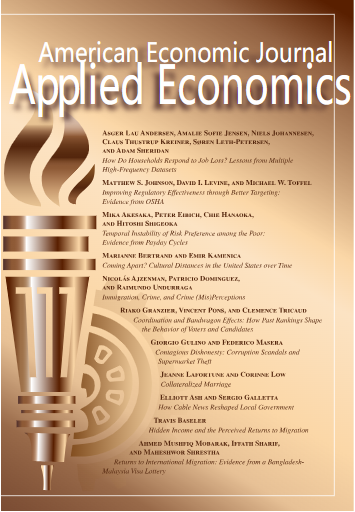Coming Apart? Cultural Distances in the United States over Time
IF 6.2
1区 经济学
Q1 ECONOMICS
引用次数: 0
Abstract
We analyze trends in cultural distances between groups in the United States defined by income, education, gender, race, and political ideology. We measure cultural distance as the ability to infer an individual's group based on media diet, consumer behavior, time use, social attitudes, or newborn's name. Gender difference in time-use decreased between 1965 and 1995 and has remained constant since. Differences in social attitudes by political ideology, and somewhat by income, have increased over the last four decades. Whites and non-Whites have diverged in consumer behavior. For all other demographic divisions and cultural dimensions, cultural distance has been broadly constant over time. (JEL D12, D91, J15, J16, L82, Z13)会分开吗?美国不同时期的文化距离
我们分析了由收入、教育、性别、种族和政治意识形态定义的美国群体之间文化距离的趋势。我们测量的文化距离是根据媒体饮食、消费者行为、时间使用、社会态度或新生儿的名字来推断个人所属群体的能力。时间利用方面的性别差异在1965年至1995年期间有所下降,此后一直保持不变。在过去的四十年里,政治意识形态和收入在社会态度上的差异有所增加。白人和非白人在消费行为上存在分歧。对于所有其他人口划分和文化维度,文化距离一直大致保持不变。(jel d12, d91, j15, j16, l82, z13)
本文章由计算机程序翻译,如有差异,请以英文原文为准。
求助全文
约1分钟内获得全文
求助全文
来源期刊

American Economic Journal-Applied Economics
ECONOMICS-
CiteScore
9.10
自引率
1.60%
发文量
63
期刊介绍:
American Economic Journal: Applied Economics publishes papers covering a range of topics in applied economics, with a focus on empirical microeconomic issues. In particular, we welcome papers on labor economics, development microeconomics, health, education, demography, empirical corporate finance, empirical studies of trade, and empirical behavioral economics.
 求助内容:
求助内容: 应助结果提醒方式:
应助结果提醒方式:


